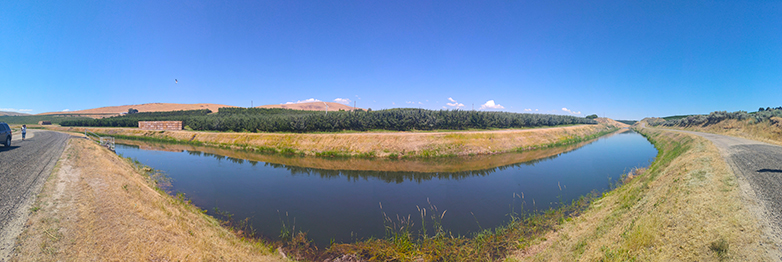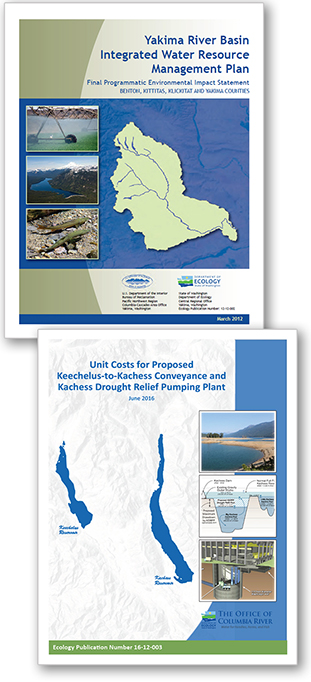Yakima River Basin Integrated Plan
The Yakima Basin is home to 400,000 people and a $4.5 billion agriculture industry. With warming winter temperatures threatening aquifers and snowpack, the Basin is facing the challenges of water supplies under pressure. The Yakima Basin Integrated Plan brings together a coalition of local, state, and federal partners to find collaborative solutions and stabilize water supplies for future generations.
Seeking integrated water solutions
The Yakima Basin Integrated Water Management Plan offers a commonsense approach to solving decades of water conflicts in the Yakima River Basin. It offers a 30-year vision for responding to drought and changing climate, assuring water is clean and ample, and lands are both protected and productive for growing communities and the natural environment.
We work in cooperation with the US Bureau of Reclamation, Yakama Nation, farmers, cities, counties, and environmental interests to implement projects to achieve integrated water solutions in the Yakima River Basin.
Our Office of Columbia River helped develop a new approach for water resource management that sets aside historic clashes over water, helping us to respond during times of drought and to prepare for a changing climate.
The Yakima River Basin Integrated Water Management Plan builds on decades of work to achieve water security that began in the 1980s through the federal Yakima River Basin Water Enhancement Project.
Years of litigation and successive droughts brought irrigation districts, environmental organizations, the Yakama Nation, and federal, state, county, and city governments to the table to form the Yakima River Basin work group to develop the plan.
In 2013, the Legislature recognized the need to find sustainable water solutions that meet both instream and out-of-stream benefits in the region by authorized funding for the initial development phase of the Yakima Basin Integrated Plan.
Protecting and restoring a diverse watershed
The Yakima River flows through Kittitas and Yakima counties and empties into the Columbia River in Benton County. Snowpack in the Cascade Range feeds the river supporting fertile valley crops, streamflows, and groundwater resources. The river and its tributaries are home to important fish spawning, rearing, and ocean migration as part of the greater Columbia River watershed.
The basin has a population of nearly 400,000 people and supports the federal Bureau of Reclamation's large Yakima Irrigation Project, local irrigation districts and some of the state's earliest water rights for individuals and cities. Apples, cherries, wine grapes, hops, corn, and hay are top crops produced in the watershed, supporting a $4.5 billion agriculture growing and processing industry
The watershed is the ancestral home to the Yakama Indian Nation, whose rights memorialized in the Treaty of 1855 recognize inherent fishing, hunting, and migration rights, including those supporting important salmon species. The river hosts a variety of endangered and threatened fish species and offers some of the best opportunities for sockeye reintroduction and habitat restoration in the state.
The region has experienced numerous droughts, including an unprecedented snowpack drought in 2015. And climate change predictions forecast the valley's precipitation will change from snow to rain.
Moving forward
Goals of the 30-year water resiliency plan are to protect and enhance fish and natural resources, improve water availability and reliability, establish more efficient water markets, manage the variability of water supplies, and prepare for the uncertainties of climate change through operational and structural changes.
The plan addresses seven elements:
- Fish passage
- Fish habitat enhancement
- Modifying existing irrigation structures and operations
- Surface storage
- Water market-based reallocation (water banks)
- Groundwater storage
- Enhanced water conservation
Phased implementation
Through state, federal, local, and private funding, we're moving the initial development phase of Yakima Basin Integrated Plan forward. Projects in the plan advance concurrently some portion of the seven elements. The overall plan is outlined in Yakima River Basin Integrated Water Resource Management Plan environmental impact statement.
More Information
Reports to the Legislature
- Yakima River Basin Integrated Water Resource Management Plan 2021 Implementation Status and 2022 Cost Estimate & Financing Plan Combined Report (2022)
- Yakima River Basin Integrated Water Resource Management Plan Implementation Status Report (2019)
- Cost Estimate and Financing Plan Yakima River Basin Integrated Water Resource Management Plan (2018)
- Yakima River Basin Integrated Water Resource Management Plan Implementation Status Report (2017)
- Previous Reports
Other studies and reports
- Water Security for the Yakima River Basin’s Economy, Communities, and Watersheds (Economic study - 2017)
- Groundwater Storage Potential in the Yakima River Basin: A Spatial Assessment of Shallow Aquifer Recharge and Aquifer Storage and Recovery
- Real Property Value Impacts Study in Connection With Kachess Drought Relief Pumping Plant
- All studies and reports
Environmental Impact Statements
- Yakima Basin integrated Plan 2023 Highlights
- Yakima Basin Integrated Plan 2022 Highlights
- Yakima Basin Integrated Plan 2021 Highlights
- Yakima Basin Integrated Plan 2020 Highlights
- Yakima Basin Integrated Plan 2019 Highlights
- Yakima Basin Integrated Plan 2018 Highlights
- Yakima Basin Integrated Plan Primer (Jan. 2019)
The Yakima Basin Integrated Plan: This River Runs Forever
Related links
Contact information
Tim Poppleton
Office of Columbia River web coordinator
tim.poppleton@ecy.wa.gov
509-454-4241






